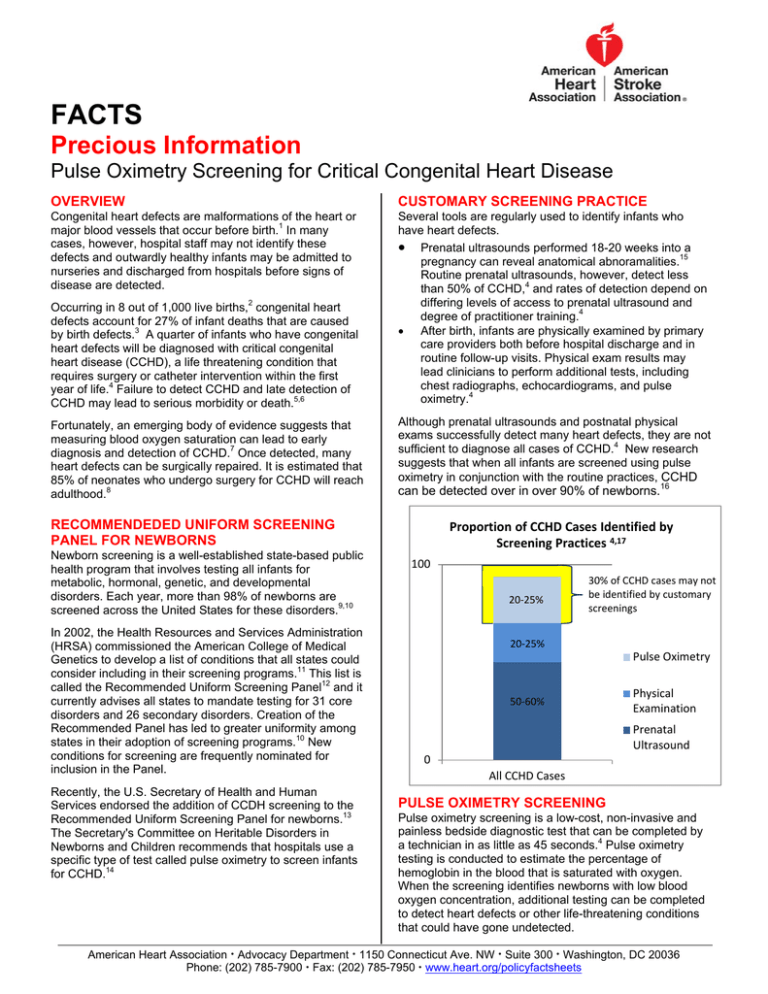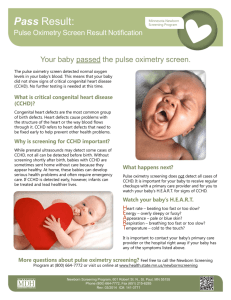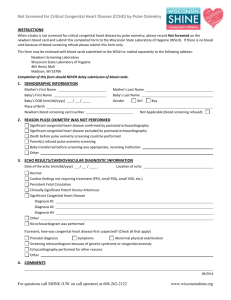Pulse Oximetry Screening for Critical Congenital Heart Disease
advertisement

FACTS Precious Information Pulse Oximetry Screening for Critical Congenital Heart Disease OVERVIEW CUSTOMARY SCREENING PRACTICE Congenital heart defects are malformations of the heart or major blood vessels that occur before birth.1 In many cases, however, hospital staff may not identify these defects and outwardly healthy infants may be admitted to nurseries and discharged from hospitals before signs of disease are detected. Several tools are regularly used to identify infants who have heart defects. Prenatal ultrasounds performed 18-20 weeks into a pregnancy can reveal anatomical abnoramalities.15 Routine prenatal ultrasounds, however, detect less than 50% of CCHD,4 and rates of detection depend on differing levels of access to prenatal ultrasound and degree of practitioner training.4 After birth, infants are physically examined by primary care providers both before hospital discharge and in routine follow-up visits. Physical exam results may lead clinicians to perform additional tests, including chest radiographs, echocardiograms, and pulse oximetry.4 Occurring in 8 out of 1,000 live births,2 congenital heart defects account for 27% of infant deaths that are caused by birth defects.3 A quarter of infants who have congenital heart defects will be diagnosed with critical congenital heart disease (CCHD), a life threatening condition that requires surgery or catheter intervention within the first year of life.4 Failure to detect CCHD and late detection of CCHD may lead to serious morbidity or death.5,6 Fortunately, an emerging body of evidence suggests that measuring blood oxygen saturation can lead to early diagnosis and detection of CCHD.7 Once detected, many heart defects can be surgically repaired. It is estimated that 85% of neonates who undergo surgery for CCHD will reach adulthood.8 Although prenatal ultrasounds and postnatal physical exams successfully detect many heart defects, they are not sufficient to diagnose all cases of CCHD.4 New research suggests that when all infants are screened using pulse oximetry in conjunction with the routine practices, CCHD can be detected over in over 90% of newborns.16 RECOMMENDEDED UNIFORM SCREENING PANEL FOR NEWBORNS Newborn screening is a well-established state-based public health program that involves testing all infants for metabolic, hormonal, genetic, and developmental disorders. Each year, more than 98% of newborns are screened across the United States for these disorders.9,10 In 2002, the Health Resources and Services Administration (HRSA) commissioned the American College of Medical Genetics to develop a list of conditions that all states could consider including in their screening programs.11 This list is called the Recommended Uniform Screening Panel12 and it currently advises all states to mandate testing for 31 core disorders and 26 secondary disorders. Creation of the Recommended Panel has led to greater uniformity among states in their adoption of screening programs.10 New conditions for screening are frequently nominated for inclusion in the Panel. Recently, the U.S. Secretary of Health and Human Services endorsed the addition of CCDH screening to the Recommended Uniform Screening Panel for newborns.13 The Secretary's Committee on Heritable Disorders in Newborns and Children recommends that hospitals use a specific type of test called pulse oximetry to screen infants for CCHD.14 Proportion of CCHD Cases Identified by Screening Practices 4,17 100 20‐25% 30% of CCHD cases may not be identified by customary screenings 20‐25% Pulse Oximetry 50‐60% Physical Examination Prenatal Ultrasound 0 All CCHD Cases PULSE OXIMETRY SCREENING Pulse oximetry screening is a low-cost, non-invasive and painless bedside diagnostic test that can be completed by a technician in as little as 45 seconds.4 Pulse oximetry testing is conducted to estimate the percentage of hemoglobin in the blood that is saturated with oxygen. When the screening identifies newborns with low blood oxygen concentration, additional testing can be completed to detect heart defects or other life-threatening conditions that could have gone undetected. American Heart Association Advocacy Department 1150 Connecticut Ave. NW Suite 300 Washington, DC 20036 Phone: (202) 785-7900 Fax: (202) 785-7950 www.heart.org/policyfactsheets FACT SHEET: Pulse Ox Screening for CCHDs Many studies show that pulse oximetry screening for CCHD has a less than one percent chance of giving false positive results.18 False positive screening results for CCHD can still offer information to doctors: roughly 25% of infants identified as having low blood oxygen without CCHD may be diagnosed with other conditions that require medical intervention. 19 The American Heart Association (AHA), the American Academy of Pediatrics (AAP), and the American College of Cardiology Foundation (ACCF) recently outlined recommendations for a standardized pulse oximetry screening approach and diagnostic follow-up.7 According to these recommendations, screening should be performed on asymptomatic newborns after 24 hours of life in order to avoid false-positive results.7 When pulse oximetry screening identifies newborns with low blood oxygen levels, echocardiography can be used to definitively diagnose heart defects.4 The AHA/AAP/ACCF recommendations emphasize that echocardiograms should be interpreted by pediatric cardiologists.7 Studies have shown that underserved and rural areas can use telemedicine to access pediatric cardiologists for CCHD diagnosis.20,21 Pulse oximeters are available in most neonatal units, and hospital staff are well trained in how to perform pulse oximetry screening.18 A recent cost-effectiveness analysis estimated that universal newborn pulse oximetry screening would cost just under $4 per infant.22 Although there are monetary costs associated with false positive results from pulse oximetry screening, these costs may be partially or fully offset by early diagnosis of infants with CCHD before they become ill and/or incur irreversible damage. Research suggests that the cost savings associated with early detection of a single case of CCHD could exceed the costs associated with screening 2,000 infants.16 Many clinicians and experts agree that the benefits of detecting CCHD far outweigh the costs incurred by the screening itself. Although there is not a clear way to bill insurers for pulse oximetry screening at this time, many other routine newborn tests, including hearing screenings, are frequently included in the bundle of services that hospitals provide to infants prior to discharge.7 STATE POLICY APPROACHES TO CCHD SCREENING States across the nation are beginning to work to implement the Secretary’s recommendation to screen all newborns for CCHD. State policies have a substantial effect on newborn screening rates. Research shows that screening rates are significantly higher in states that have passed test-specific legislation than in states without these laws.27 While some individual providers or hospital systems may initiate voluntary pulse oximetry screening, legislative action is the only way to ensure equitable and uniform CCHD screening for all newborns THE AHA ADVOCATES The AHA is committed to advancing public policies that will allow children and adults with heart defects to live longer and fuller lives. These policies include: State adoption of mandatory CCHD screening using pulse oximetry for all newborns; The collection of screening data to be used for surveillance, evaluation and continuous quality improvement of CCHD screening;7 The development, dissemination, and validation of screening standards for CCHD; The continued development of FDA’s guidance document regarding the safety and effectiveness of pulse oximeters.29 _______________________________________________________________________________________ References 1. American Heart Association. Common Types of Heart Defects. 2012. Available at: http://www.heart.org/HEARTORG/Conditions/CongenitalHeartDefects/AboutCongenitalHeart Defects/Common-Types-of-Heart-Defects_UCM_307017_Article.jsp. Accessed June 12, 2012. 2. Reller MD, Strickland MJ, Riehle-Colarusso T, Mahle WT, Correa A. Prevalence of congenital heart defects in metropolitan Atlanta, 1998–2005. J Pediatr. 2008;153:807– 813. 3. Go AS, Mozaffarian D, Roger VL, et. al. Heart disease and stroke statistics—2013 update: a report from the American Heart Association. Circulation. 2013;127:e6-e245 . 4. Mahle WT, Newburger JW, Matherne GP, et al. Role of Pulse Oximetry in Examining Newborns for Congenital Heart Disease: A Scientific Statement From the American Heart Association and American Academy of Pediatrics. Circulation. 2009;120(5):447–458. 5. Chang R-KR, Gurvitz M, Rodriguez S. Missed Diagnosis of Critical Congenital Heart Disease. Arch Pediat Adol Med. 2008;162(10):969–974. 6. Riehle-Colaruss T, Mahle WT, Correa A. Death due to delayed diagnosis of congenital heart disease: a contemporary population-based study. Congenit Heart Dis. 2007;2:376. Abstract. 7. Kemper AR, Mahle WT, Martin GR, et al. Strategies for Implementing Screening for Critical Congenital Heart Disease. Pediatrics. 2011;128(5):e1259–e1267. 8. Warnes CA, Williams RG, Bashore TM, et al. ACC/AHA 2008 Guidelines for the Management of Adults With Congenital Heart Disease: Executive Summary. Circulation. 2008;118(23):2395–2451. 9. Centers for Disease Control and Prevention. Using tandem mass spectrometry for metabolic disease screening among newborns. MMWR. 2001;50(RR03):1–22. 10. Centers for Disease Control and Prevention. Impact of expanded newborn screening— United States, 2006. MMWR. 2008;57(37):1012–105. 11. Watson MS, Mann MY, Lloyd-Puryear MA, Rinaldo P, Howell RR. Newborn screening: toward a uniform screening panel and system. Genet. Med. 2006;8 Suppl 1:1S–252S. 12. Secretary’s Advisory Committee on Heritable Disorders in Newborns and Children. Recommended Uniform Screening Panel. Health Resources and Services Administration; 2011:1–2. 13. Sebelius K. HHS Secretary adopts recommendation to add Critical Congenital Heart Disease to the Recommended Uniform Screening Panel. 2011. Available at: http://www.hrsa.gov/advisorycommittees/mchbadvisory/heritabledisorders/recommendations/c orrespondence/cyanoticheartsecre09212011.pdf. Accessed June 11, 2012. 14. Secretary’s Advisory Committee on Heritable Disorders in Newborns and Children. Addition of Critical Congenital Cyanotic Heart Disease to the Committee’s Recommended Uniform Screening Panel. 2010. Available at: http://www.hrsa.gov/advisorycommittees/mchbadvisory/heritabledisorders/recommendations/c orrespondence/criticalcongenital.pdf. Accessed June 12, 2012. 15. Allan LD. A practical approach to fetal heart scanning. Semin Perinatol. 2000;24(5):324– 330. 16. de-Wahl Granelli A, Wennergren M, Sandberg K, et al. Impact of pulse oximetry screening on the detection of duct dependent congenital heart disease: a Swedish prospective screening study in 39 821 newborns. BMJ. 2009;338(jan08 2):a3037–a3037. 17. Abu-Harb M, Wyllie J, Hey E, Richmond S, Wren C. Presentation of obstructive left heart malformations in infancy. Arch Dis Child. 1994;71:F179–F183. 18. Hoffman JIE. It Is Time for Routine Neonatal Screening by Pulse Oximetry. Neonatology. 2011;99(1):1–9. 19. Ewer A, Furnston A, Middleton L, et al. Pulse oximetry as a screening test for congenital heart defects in newborn infants: a test accuracy study with evaluation of acceptability and cost-effectiveness. Health Technol Assess. 2012;16(2). Available at: http://www.hta.ac.uk/fullmono/mon1602.pdf. Accessed June 13, 2012. 20. Danford DA. Clinical and basic laboratory assessment of children for possible congenital heart disease. Curr Opin Pediatr. 2010;12(5):487–491. 21. Sable CA, Cummings SD, Pearson GD, et al. Impact of Telemedicine on the Practice of Pediatric Cardiology in Community Hospitals. Pediatrics. 2002;109(1):e3–e3. 22. Peterson C, Grosse SD, Cassell CH, Oster ME, Olney RS. Abstract 228: A Costeffectiveness Analysis Of Universal Pulse Oximetry Screening To Detect Critical Congenital Heart Disease In U.S. Newborns. Circ Cardiovasc Qual Outcomes. 2012;5:A228. 23. State of Indiana. Prevention and Treatment Programs: Examination of Infants for Phenylketonuria, Hypothyroidism, and Other Disorders.; 2011. Available at: http://www.in.gov/legislative/ic/2010/title16/ar41/ch17.html. Accessed June 14, 2012. 24. Colorado General Assembly. House Joint Resolution 12-1014.; 2012. Available at: http://www.statebillinfo.com/bills/bills/12/HJR1014_enr.pdf. Accessed June 14, 2012. 25. Georgia General Assembly. HB 745 2011-2012 Regular Session.; 2012. Available at: http://www.legis.ga.gov/legislation/en-US/Display/20112012/HB/745. Accessed June 15, 2012. 26. Minnesota Department of Health. Newborn Screening Parental Options. 2012. Available at: http://www.health.state.mn.us/newbornscreening/optout.html. Accessed June 25, 2012. 27. Green DR, Gaffney M, Devine O, Grosse SD. Determining the Effect of Newborn Hearing Screening Legislation: An Analysis of State Hearing Screening Rates. Public Health Rep. 2007;122(2):198–205. 28. Schwamm LH, Audebert HJ, Amarenco P, et al. Recommendations for the Implementation of Telemedicine Within Stroke Systems of Care A Policy Statement From the American Heart Association. on behalf of the American Heart Association Stroke Council; Council on Epidemiology and Prevention; Interdisciplinary Council on Peripheral Vascular Disease; and the Council on Cardiovascular Radiology and Intervention, ed. Stroke. 2009;40:2635–2660. 29. US Food and Drug Administration. Draft Guidance for Industry and FDA Staff: Pulse Oximeters - Premarket Notification Submissions [510(k)s]. US Food and Drug Administration, Center for Devices and Radiological Health; 2007:1–21. Available at: http://www.fda.gov/downloads/MedicalDevices/DeviceRegulationandGuidance/GuidanceDocu ments/ucm071376.pdf. Accessed June 12, 2012. AHA/HPFS/02/2013

